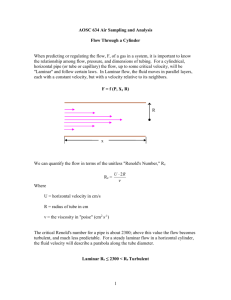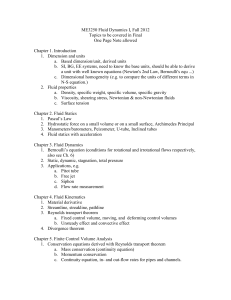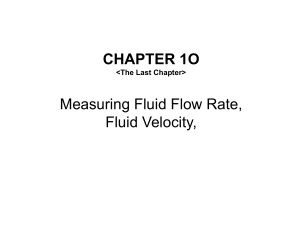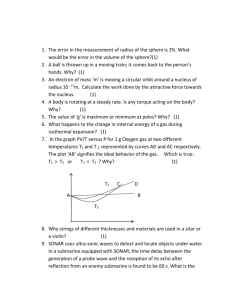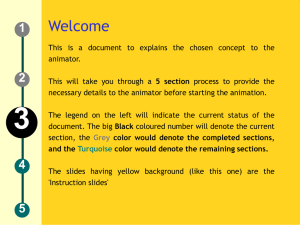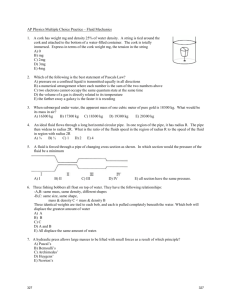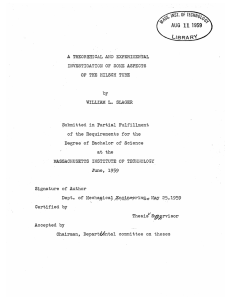Name: #1 Plug in a Dam You are working as a summer intern for the
advertisement
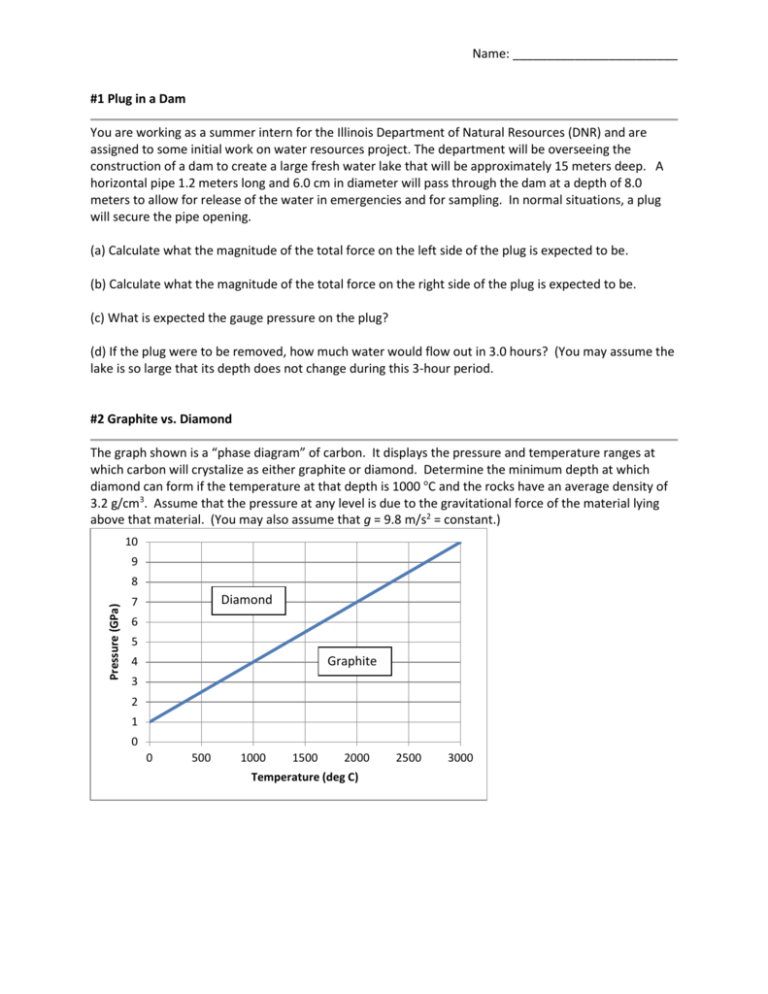
Name: ________________________ #1 Plug in a Dam You are working as a summer intern for the Illinois Department of Natural Resources (DNR) and are assigned to some initial work on water resources project. The department will be overseeing the construction of a dam to create a large fresh water lake that will be approximately 15 meters deep. A horizontal pipe 1.2 meters long and 6.0 cm in diameter will pass through the dam at a depth of 8.0 meters to allow for release of the water in emergencies and for sampling. In normal situations, a plug will secure the pipe opening. (a) Calculate what the magnitude of the total force on the left side of the plug is expected to be. (b) Calculate what the magnitude of the total force on the right side of the plug is expected to be. (c) What is expected the gauge pressure on the plug? (d) If the plug were to be removed, how much water would flow out in 3.0 hours? (You may assume the lake is so large that its depth does not change during this 3-hour period. #2 Graphite vs. Diamond The graph shown is a “phase diagram” of carbon. It displays the pressure and temperature ranges at which carbon will crystalize as either graphite or diamond. Determine the minimum depth at which diamond can form if the temperature at that depth is 1000 oC and the rocks have an average density of 3.2 g/cm3. Assume that the pressure at any level is due to the gravitational force of the material lying above that material. (You may also assume that g = 9.8 m/s2 = constant.) 10 9 Pressure (GPa) 8 Diamond 7 6 5 Graphite 4 3 2 1 0 0 500 1000 1500 2000 Temperature (deg C) 2500 3000 #3 Hydraulic Lift A hydraulic lift has two connected pistons with cross-sectional areas 20 cm2 and 480 cm2. It is filled with oil of density 720 kg/m3. a) What mass must be placed on the small piston to support a car of mass 1200 kg at equal fluid levels? b) With the lift in balance with equal fluid levels, a person of mass 64 kg gets into the car. What is the equilibrium height difference in the fluid levels in the pistons? c) How much did the height of the car drop when the person got in the car? #4 Rod in Fluid A metal alloy rod is submerged 16 cm below the surface of a fresh water pool by steel cables tied 10 cm from each end. It has a length of 90 cm, a mass of 180 kg and a uniform square cross-sectional area of 5.5 cm2. Because its density is not uniform, its center of mass is located 25 cm from the left end. The total depth of the water is 48 cm. (a) Calculate the magnitude of the tension in the left cable? (b) What is the magnitude of the tension in the right cable? #5 Weighted Block A block of wood has a mass of 3.0 kg and a density of 63 kg/m3. It is to be loaded with copper metal so that it will float in water with 0.90 of its volume submerged below the surface. What is the mass of copper is needed if… (a) …the copper is placed on top of the wood block? (b) …the copper is secured to the bottom of the wood block? #6 Floating Cylinders Two cylinders with the same mass density C = 715 kg / m3 are floating in a container of sea water (with mass density w = 1025 kg / m3. Cylinder #1 has a length of L1 = 20 cm and radius r1 = 5 cm. Cylinder #2 has a length of L1 = 10 cm and radius r1 = 10 cm. If h1 and h2 are the heights that these cylinders stick out above the water, what is the ratio of the height of Cylinder #2 above the water to the height of Cylinder #1 above the water (h1 / h1)? (Note: The image is not draw to scale.) #7 Merging Streams Two streams merge together to form a river. The first stream is 8.2 m wide, 3.4 m deep, and flows at a speed of 2.3 m/s. The second stream has a width of 6.8 m, depth of 3.2 m, and a current speed of 2.6 m/s. After merging, the river is 10.5 m wide and flows at a speed of 2.9 m/s. Calculate the depth of the river. #8 Aspirator A tube of radius 5 cm is connected to tube of radius 1 cm as shown above. Water is forced through the tube at a rate of 10 liters/min. The pressure in the 5 cm tube is 105 Pa. The density of water is 1000 kg/m3. Assume that the water behaves as an ideal fluid. (a) What is the velocity of the water in the 5 cm radius tube? (b) What is the velocity of the water in the 1 cm radius tube? (c) What is the water pressure in the 1 cm radius tube? (d) If a hole is punched in the 1 cm tube, does water drip out? #9 Water Pipe A long horizontal pipe of diameter 4.0 cm is connected to a faucet. At the other end, there is a nozzle of diameter 1.6 cm. Water squirts from the nozzle at velocity 12 m/sec. Assume that the water behaves as an ideal fluid. (a) Calculate the velocity of the water in the pipe. (b) Calculate the pressure differential between the water in the hose and water in the nozzle. (c)How long will it take to fill a tub of volume 85 liters with the pipe? (d) If the nozzle is raised by a height 2.4 m above the pipe level, what is the velocity of water leaving the nozzle? (Assume the pressure at the inlet part of the pipe (where it connects to the faucet) remains the same.) #10 Viscous Fluid A very large storage tank is filled to a depth of 250 cm with oil having a density of 860 kg/m3 and a viscosity of 180 mPa.s. A circular hole of radius 0.75 cm is drilled vertically through the 5.0-cm thick floor of the tank. (a) Calculate the initial volume flow rate (in liters/s) of the oil as it runs out of the hole. (Hint: Since we are now dealing with a viscous fluid, you cannot simply use the Bernoulli equation to find the speed of the oil through the hole.) (b) Calculate the speed at which the oil flows out of the hole. (c) Calculate the Reynold’s number and determine whether the oil flow is laminar, unstable or turbulent.

